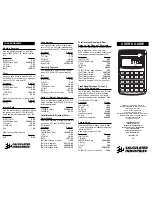
830
Appendix A: Functions and Instructions
Input
[
promptString
,
]
var
Input
[
promptString
],
var
pauses the program,
displays
promptString
on the Program I/O screen,
waits for you to enter an expression, and stores
the expression in variable
var
.
If you omit
promptString
, “?” is displayed as a
prompt.
Program segment:
©
:For i,1,9,1
: "Enter x" & string(i)
!
str1
: Input str1,#(right(str1,2))
:EndFor
©
InputStr
CATALOG
InputStr
[
promptString
,
]
var
Pauses the program, displays
promptString
on the
Program I/O screen, waits for you to enter a
response, and stores your response as a string in
variable
var
.
If you omit
promptString
, “?” is displayed as a
prompt.
Note:
The difference between
Input
and
InputStr
is that
InputStr
always stores the
result as a string so that “ ” are not required.
Program segment:
©
:InputStr "Enter Your Name",str1
©
inString()
MATH/String menu
inString(
srcString
,
subString
[
,
start
]
)
⇒
⇒
⇒
⇒
integer
Returns the character position in string
srcString
at
which the first occurrence of string
subString
begins.
start
, if included, specifies the character position
within
srcString
where the search begins. Default
= 1 (the first character of
srcString
).
If
srcString
does not contain
subString
or
start
is >
the length of
srcString
, returns zero.
inString("Hello there","the")
¸
7
"ABCEFG"
!
s1:If inString(s1,
"D")=0:Disp "D not found."
¸
D not found.
int()
CATALOG
int(
expression
)
⇒
⇒
⇒
⇒
integer
int(
list1
)
⇒
⇒
⇒
⇒
list
int(
matrix1
)
⇒
⇒
⇒
⇒
matrix
Returns the greatest integer that is less than or
equal to the argument. This function is identical
to
floor()
.
The argument can be a real or a complex number.
For a list or matrix, returns the greatest integer of
each of the elements.
int(
ë
2.5)
¸
ë
3.
int([-1.234,0,0.37])
¸
[-2. 0 0.]
intDiv()
CATALOG
intDiv(
number1
,
number2
)
⇒
⇒
⇒
⇒
integer
intDiv(
list1
,
list2
)
⇒
⇒
⇒
⇒
list
intDiv(
matrix1
,
matrix2
)
⇒
⇒
⇒
⇒
matrix
Returns the signed integer part of argument 1
divided by argument 2.
For lists and matrices returns the signed integer
part of argument 1 divided by argument 2 for
each element pair.
intDiv(
ë
7,2)
¸
ë
3
intDiv(4,5)
¸
0
intDiv({12,
ë
14,
ë
16},{5,4,
ë
3})
¸
{2
ë
3 5}
integrate
See
‰‰‰‰
()
, page 907.
Summary of Contents for Voyage 200
Page 36: ...Getting Started 36 D B D B Press Result ...
Page 45: ...Getting Started 45 3 0 D B D D B D Press Result ...
Page 46: ...Getting Started 46 D 2 0 0 2 D B Scroll down to October and press Press Result ...
Page 60: ...Getting Started 60 B D Press Result ...
Page 139: ...Previews 139 8 Complete the operation Press 2 d Steps and keystrokes Display 5 f 2 ...
Page 453: ...Differential Equation Graphing 453 ...
Page 468: ...Tables 468 ...
Page 777: ...Activities 777 ...
















































